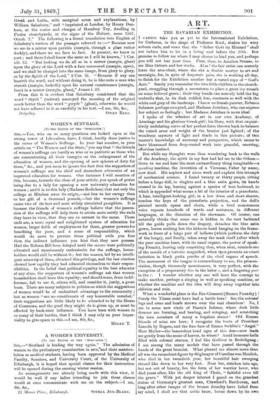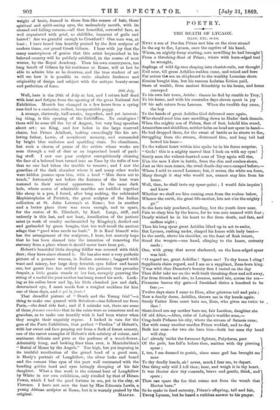ART.
I CANNOT take you as yet to the International Exhibition, for Cerberus, in the shape of Professor Knol, shakes his wiry auburn curls, and vows that the " Heber Gott im Himmel " shall not induce him to let in a living soul before the 20th. But promise to follow me where I may choose to lead you, and perhaps you will not lose your time. First, then, to Amalien Straw, to see Miss Osborn and her studio. Al as ! the fair artist can scarcely leave the arm-chair, where she sits a double martyr tp art and neuralgia, for, in spite of desperate pain, she is working all day, to finish for the Exhibition another but a varied copy of " God's Acre." Surely you remember the two little children iu the church- yard, struggling through a snowstorm to place a great ivy wreath on some beloved grave ; their tiny hands can scarcely hold the big umbrella that, in its dusk reddish hue, contrasts so well with the white and grey of the landscape. I know no female painter, Rebecca Solomon perhaps excepted, and Madame Jerichau, who can express her subject so feelingly ; but Madame Jerichau is more ideal.
I spoke of the wanders of art in our own Academy, of
Armitage and his glorious Greek girls; his Hero, with that exquisi- tively undulating curve of her perfect form thrown back to balance the raised arms and weight of the brazier just lighted ; of the wondrous mystery of light and shade in this picture ; of this master's knowledge of anatomy and perspective, which seems to have blossomed from deep-rooted work into graceful, unerring, effortless instinct.
But while my thoughts were thus wandering back to the walls of the Academy, the spirit in my feet had led me to the Odeon— there to see and hear the most extraordinary thing imaginable—a speaking machine, the invention of a Viennese, Faber by name, now dead. His nephew and niece work and explain this triumph of mechanical science. I found twenty or thirty people sitting before a large doll, in ringlets and a blue satin gown, its hands crossed in its lap, leaning against a species of tent bedstead, to which is appended what seems a bit of the interior of a pianoforte. A lean, intelligent-looking girl, in a low dress and short sleeves, touches the keys of the pianoforte projection, and the doll's painted mouth opens and shuts, while a loud monotonous voice repeats hundreds of words and sentences, in different languages, at the dictation of the showman. Of course, one naturally thinks that some one is hidden in the tent bedstead till the guide pulls down the drapery, detaches the blue satin gown, leaves nothing but the hideous head hanging on the frame- work in front of a large pair of bellows (which perform the duty of the lungs), and finally, takes away the mask itself (after which the poor machine loses, with its nasal organs, the power of speak- ing French), leaving only something that, when shut, reminds one of the mouth of a tortoise magnified, when open presents an exact imitation in black gutty percha of the chief organs of speech. The movement of the tongue is extraordinary to see, the pronun- ciation, though tiresomely monotonous, is very perfect, with the exception of a preparatory hiss in the letter s, and a lingering gurr in the r. I wonder whether any one will have the courage to make another, perhaps a singing as well as speaking machine, or whether the machine and the idea will drop away together into oblivion and ruin.
What a wonderful place is the Erz-Giesserei (Bronze Foundry) !
Surely the Titans must have had a battle here ! See the colossal legs and arms and heads strewn over the vast chambers ! No, I am in some new circle of Dante's Inferno, where dark little demons are burning, and beating, and scraping, and scratching the torn members of many a hopeless sinner ! Old Roman friends of mine are here ; I recognize the hoots of President Lincoln by Rogers, and the fine face of Emma Stebbiu's "Angel." Herr Miiller—the benevolent head ogre of this den—now leads me gently from the scene of horror, to where? Amid immense halls filled with colossal statues, I feel like Gulliver in Brobdignag ; I am among the many models that have passed through the hands of the great bronzist. What pleased me almost more than all was the recumbent figure by Stiglmayer of Caroline von Miinlich, who died in her twentieth year, her beautiful hair sweeping shroud -like down to her very feet. Near her, stricken into age, but not out of beauty, lies the form of her warrior lover, who died years after, like the old king of Thule, " faithful even till the grave." With yet deeper interest I gazed on the grandest statue of Germany's greatest man, Crawford's Beethoven, and long after other images of the bronze foundry have faded from my mind, I shall see that noble brow, borne down by its own
weight of brain, framed in those lion-like masses of hair, those spiritual and spirit-seeing eyes, the melancholy mouth, with its creased and falling corners,—all that beautiful, sorrowful face, so well acquainted with grief, so childlike, innocent of guile and hatred ! Are we grateful enough to Crawford'? One man was, at least ; I have heard him heartily praised by the first sculptor of modern times, our grand Greek Gibson. I hear with joy that the many masterpieces of genius that this artist bequeathed to his beloved country will be publicly exhibited, in the course of next winter, by the Royal Academy. Then his own countrymen, too long bereft of Gibson by his residence at Rome, will at last be able to admire him as he deserves, and the true student of art will see how it is possible to unite absolute freshness and originality of design and subject with the antique beauty-sense and perfection of form.
20th July. Well, here is the 20th of July at last, and I return half dead with heat and fatigue from the opening of the great National Art Exhibition. Munich has changed in a few hours from a spring rose-bud to a canicular, redhot, insupportable poppy.
A strange, slatternly, half-awake, imperfect, and yet interest- ing thing, is this opening of the Exhibition. No catalogues ! there will be none till the 1st of August, but very long speeches about art ; no King, and few ladies in the large reserved chairs, but Prince Adalbert, looking exceedingly like his art- loving father, Lewis, of munificent memory, and surrounded by bright blue uniforms and sparkling stars. No cleanliness, but such a chorus of praise of the artists whose works are seen through a veil of dust or an improvised beard of pack- ing stuff. I saw one poor sculptor surreptitiously cleaning the face of a beloved bust turned into an Esau by the tufts of tow that no one had taken the trouble to remove ; and I saw the guardian of the dark chamber where it and many other works were hidden pounce upon him, with a loud " Man dares not to touch," fortunately not before the features of the bust were restored to their natural appearance. In the same dark hole, where scores of admirable marbles are huddled together like sheep in a pen, I found, after long seeking, the celebrated Mephistopheles of Pettrich, the great sculptor of the Indian collection at St. John Lateran's at Rome ; but in another and a better place there was room enough, and to spare, for the statue of St. Elizabeth, by Knol. Large, stiff, and unlovely is this last, and not least, humiliation of the patient saint (a work of cruelty unchronicled by Kingsley), decked out and garlanded by green boughs, that too well recall the ancient adage that " good wine needs no bush." It is Knol himself who has the arrangement of the sculpture, I hear, but scarcely hope that he has been shamed into the intention of removing the statuary from a place where it should never have been put.
Hebert's beautiful little sleeping fiddler was covered with thick dust ; they have since cleaned it. He has also sent a very pathetic picture of a peasant woman, in Italian costume ; haggard with want and misery, her large deep feverish eyes follow and haunt one, her gaunt face has settled into the patience that precedes despair, a little gamin stands at her feet, savagely gnawing the string of a medal the poor mother has hung round his neck. Look- ing at his sullen brow and lip, his little clenched jaw and dark, determined eye, I must needs fear a rougher necklace for him one of these days, and le qui la faute?
That dreadful picture of " Death and the Young Girl "—a thing to make one quarrel with Schubert—has followed me from Paris,—the dead ride fast ; and if I mistake not, there are some of those femmes couchees that in the salon were so numerous and so graceless, as to make one heartily wish it had been winter when they sought their ungainly repose. I looked in vain for the gem of the Paris Exhibition, that perfect " Perdita " of Hebert's, with her sweet sad face peeping out from a fleck of forest scenery, one of the rarest examples of Hebert's rich sobriety of colour, and sentiment delicate and pure as the perfume of a wood-flower. Admirably hung, and looking finer than ever, is Montchablon's " Burial of Moses by the Angels." Too high, but yet imposing in its truthful recollection of the grand head of a good man, is Healy's portrait of Longfellow, the silver locks and beard and the earnest blue eyes of the poet well contrasted with the bending golden head and eyes lovingly drooping of his fair daughter. What a fine work is the colossal bust of Longfellow by White in our own exhibition, only rivalled by that of Hiram Power, which I had the good fortune to see, yet in the clay, at Florence. I have not seen the bust by Miss Edmonia Lewis, a young African sculptor at Rome, but it is warmly praised by the































 Previous page
Previous page